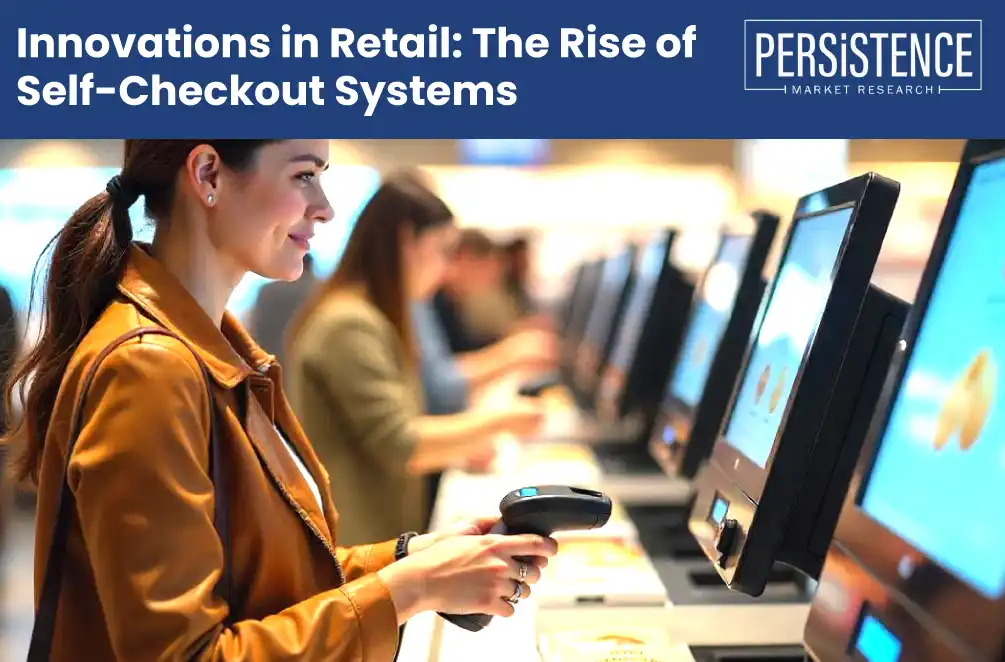- Blog
- Self Checkout Retail
Innovations in Retail: The Rise of Self-Checkout Systems
Published On : 23 Jun 2025
Self-checkout systems have quietly taken over the retail landscape, enabling customers to scan, bag, and pay for their purchases independently - no cashier assistance required. This innovation trims down those dreaded wait times with a layer of convenience and personal privacy that today’s shoppers increasingly demand. According to Capital One Shopping, a staggering 96% of grocery stores now offer self-checkout options, signaling widespread adoption that shows no signs of slowing down.
Projections estimate that over 24,000 stores will adopt self-checkout systems by 2030. Younger shoppers, particularly those aged 18 to 44, seem smitten, with 53% preferring self-checkout for its speed, shorter lines, and a bit of privacy from fellow shoppers and chatty cashiers. Sometimes, shoppers simply prefer the anonymity. Meanwhile, shoppers 45 and older tend to stick with the traditional lanes with a cartload of items as they prefer the human touch or cannot fathom the complexity of touch screens, or do not trust their calculations.

Consumer Trends and Market Growth
The growing consumer preference is not only influencing shopping behavior but also reshaping operational strategies in retail. NCR Voyix Corporation’s Digital Commerce Index highlights a major shift in U.S. consumer behavior, particularly across the dining, grocery, and fuel convenience sectors. Over 43% of consumers favor self-checkout over traditional methods. RBR Data Services forecasts that self-checkout installations in the U.S. will jump from 280,000 units in 2022 to 450,000 by 2028. Retailers, meanwhile, are not just saving on labor costs they're reallocating staff to boost in-store service and inventory management, keeping operations smooth and efficient.
Enhanced Customer Experience
Self-checkout systems aren’t just about speed, they’re about giving customers control. Tech-savvy shoppers appreciate the autonomy, while multilingual capabilities, such as Tesco’s bilingual kiosks in Wales, make shopping more inclusive. Retailers, including Costa Rica’s Megasuper, have adopted Toshiba’s Self-Checkout System 7, aiming to deliver quicker, more secure, and user-friendly checkouts. NCR FastLane SelfServ™, Diebold Nixdorf BEETLE /iSCAN EASY eXpress, and Fujitsu U-Scan Genesis II are some of the self-checkout systems adopted by retailers globally.
Advantages of Self-Checkout Systems
- Operational Efficiency: Automating checkouts means fewer cashiers, reduced labor costs, and better use of floor space. In regions including Saudi Arabia and the UAE, where labor is scarce and labor costs soar, self-checkout seems to be a natural fit. In contrast, Southeast Asia has abundant labor, impeding adoption.
- Technological Advancements: The latest self-checkouts feature AI-powered computer vision, biometric authentication, and seamless mobile payments. Imagine AI kiosks that recognize multiple items without barcodes or Amazon One’s palm recognition that lets one pay with a wave of a hand no cards, no fumbling. Smart carts equipped with RFID tech further blur the lines between shopping and checkout, charging customers as they go and potentially making traditional lines a relic of the past.
- Adaptability: Retailers, including Costco are experimenting with “Scan & Go” apps that let members scan and pay as they shop, speeding up the process and cutting down on the manual labor of receipt checks.
Challenges of Self-Checkout Systems
- Theft and Errors: Self-checkouts can be susceptible to theft or scanning mistakes. Many stores have countermeasures such as receipt scanning at exits, but occasional mishaps remind us that machines aren’t perfect. Shoplifting that shifts from the store floor to the checkout process can be counteracted by using supporting technology, which would add to the cost of installing the system.
- Customer Alienation: Some shoppers, especially those with lots of items, still prefer the human touch. Some of the customers are befuddled with the novel system, and need some assistance during billing, technical glitches or, malfunctioning of coupon codes, which defeats the very purpose of the system only. Also, there’s something about face-to-face interaction that builds loyalty, which most people who belong to older generations look forward to.
- Operational Hiccups: Self-checkout machines can be temperamental error codes, tech failures, and frequent staff intervention can disrupt the experience. These intricate technologies are prone to easy disruptions. Choosing reliable technology partners that rely on scalable and reliable structures is essential for the successful implementation of the system. In addition, the initial investment costs are vast, and rarely considered. WinCo Foods, for example, scrapped self-checkouts at one location after customer pushback favored traditional lanes.
Ethical Considerations
AI integration in retail introduces serious concerns about data privacy and fairness. Many consumers worry about how their data is collected and used, and algorithmic bias remains a hot topic. Retailers must commit to transparency and protect consumer trust to avoid turning self-checkout convenience into a privacy nightmare.
Future Trends
The future of self-checkout looks bright and smart:
- Smart Carts: AI and RFID-enabled carts let customers simply place items in their carts and walk out no scanning or waiting required. These carts sense products automatically using sensors and RFID tags, compute the total bill and enable seamless payments through mobile apps or biometrics. Retailers such as Amazon (with Dash Carts) and start-ups such as Caper AI are leading the way.
- AI and Computer Vision: These technologies enable the detection and identification of multiple items, even without barcodes through the analysis of shape, color, and texture. This reduces human errors, detects suspicious behavior, prevent theft, and guide users through the transaction, even offering prompts in multiple languages. Advanced AI models such as YOLOv10 promise faster and accurate item recognition, thereby reducing errors and boosting speed.
- Autonomous Retail: Retailers are automating from checkout to returns and inventory management. Automated return kiosks let customers drop off items without any interaction with employees. Warehouse robots can handle sorting, stocking, and order fulfilment with high precision and speed. Smart shelves, inventory-tracking drones, and robotic floor cleaners help maintain stock levels and keep the store tidy.
Wrapping Up
Self-checkout systems offer clear benefits like speed, convenience, and operational savings but also come with challenges, from theft risks to customer loyalty concerns and ethical dilemmas. As technology evolves, the integration of AI-powered smart carts and improved computer vision could redefine the checkout experience altogether.
David Wilkinson, CEO of NCR Voyix, sums it up well: self-checkout is not just a gadget; it’s a strategic tool for retailers to provide faster and friendlier services while managing staffing pressures. So the next time a shopper breezes through a self-checkout lane, they should remember they're part of a retail revolution that's only just beginning.
Industry Report

Request Report Sample
Your privacy is important to us; your data is secure
Contact Us
Latest Reports
-
In-Mold Coating Market by Product Type (Water-based, Solvent-based, Powder, Other), Substrate (Thermoplastics, Thermosetting), Industry (Electronics & Appliances, Automotive & Transport, Sanitary Products, Building & Construction, Other), and Regional Analysis for 2025 - 2032
-
Automotive Active Health Monitoring Systems Market by System Location (Driver’s Seat and Dashboard), by Component (Sensors, Software and Hardware), Application Outlook (Pulse Rate, Blood Sugar Level, Blood Pressure and Misc.), End-user (Passenger Car, LCV and HCV) and Regional Analysis for 2025 - 2032
-
Medical Oxygen Cylinders Market by Product (Fixed Medical Oxygen Cylinders and Portable Medical Oxygen Cylinders), by End-user (Hospitals, Specialty Clinics, Ambulatory Surgery Centers, and Home Care Settings and Others), and Regional Analysis from 2025 - 2032
-
Temporary Cardiac Pacing Wires and Leads Market by Product (Cardiac Pacing Wires and Cardiac Pacing Leads), by Application (Cardiothoracic Surgeries, Acute Myocardial Infarction, Bradycardia, Heart Blocks, Sick Sinus Syndrome, and Congestive heart failure (CHF)), Technique (Epicardial Pacing, Transvenous Pacing, and Transcutaneous Pacing), Age Group (Pediatric, and Adult), by End-user, and Regional Analysis from 2025 - 2032
-
Hospital Acquired Pneumonia Prevention Market by Product (Oral Care Kits, Toothbrush, Vaccines, Swab, Moisturizer, Mouth Wash, Suction Tools, and Others), End User (Hospitals, Rehabilitation Centers, Ambulatory Surgery Centers, Home Care Settings, and Others), and Regional Analysis from 2025 to 2032
